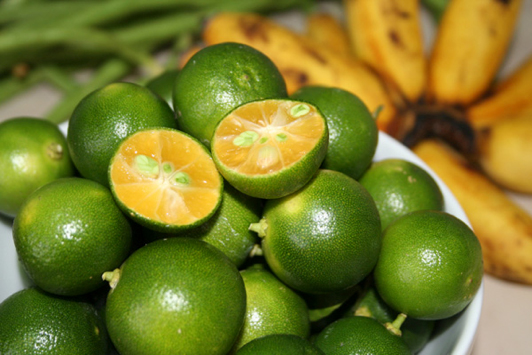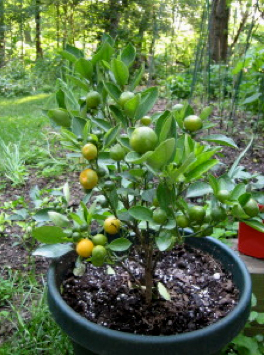The woman was 73 years old and traveling to different countries several times a year, with a clean bill of health. My daughter wondered what the secret was to her grandmother’s good health. Of course, she automatically determined that is was from her diet, which consisted of a lot of greens and fruits. What amazed her more was discovering that most of the foods she consumed came directly from her backyard. My daughter had discovered a great idea for a science project to present at the Islandwide Science Fair to see if home-grown fruits and vegetables were more beneficial than store-bought ones. The information surprised us even though we had a clue. There’s something about numbers that put things in proper measure and perspective. This article will provide nutritional information, cost-saving results, tips on what to plant. In our next article, we’ll provide popular local recipes using these fresh ingredients.
The plants discussed are mainly found in the backyard of Grandma (or Lola as she is lovingly called) to give you a snapshot of the scale and maintenance of her agricultural activity, which is small and low. And because of needing virtually minimal to no maintenance, and are resilient to Guam’s weather, these veggies are widely planted in many local gardens.
On the list for fruits: mango, calamansi, guava, saba banana, papaya and avocado, mountain apple, and sour sop. Vegetables: Moringa, bitter melon, green onion leaves, sweet potato, taro, and squash. Most of these plants look like overgrowth, or ornamental trees, but what they bear and yield is an endless supply of rich and wholesome goodness. Let the USDA nutritional information below speak for itself.
Home-Grown Vs. Store-bought Fruit and Vegetables
(click for larger image)
The Results
The backyard tropical fruits packed in more vitamin C than imported fruits according to the USDA nutrient database when comparing both to 3.5 oz. servings!
Papaya vs. Melon

 Papaya: Vitamin C 103%
Papaya: Vitamin C 103%
Melon: Vitamin C 30%
The sweet, mildly flavored fruit is used in desserts, and is found in many Mom and Pop stores pickled in huge jars. A versatile fruit that can be used as a meat tenderizer, the green versions are widely used in Asian cuisines in soups, and have been used to alleviate stomach ailments.
Planting: Grandma placed the seeds of ripe papayas in foam cups filled with soil. After it sprouted, it was planted in several places around the perimeter of the house.
Best Pickings: For green papaya, pick when it is dark green, and hollow when you knock on it. For ripe papaya, once you see the color gradations on the fruit, you can pick it off the tree and let it sit until the color changes to yellow, for a soft ripe papaya. Some may like it a little firmer so just feel the exterior of the fruit for some softness before slicing it open.
Papaya Life Cycle

Suggested Recipes: Pickled papaya, crab & garden fruit salad
Guava vs. Apple


Guava vs. Apple: Vitamin C is a whopping 371% over a Fuji Apple which only had 8%
Known as the apple of the tropics. There are different varieties that are grown in many of Guam’s backyards. White guava remains very crisp, and can grow to the size of a softball. Pink guava has a soft pink center and is a sweet delight to eat if you don’t mind the seeds.
Planting: It’s best to get a rootstock or a seedling from a nursery to ensure your tree will bear fruit. Guava trees are also drought resistant, but giving them ample water helps the tree produce more fruit. These trees may take years to grow before fruit appears, but once they do, they will not stop producing.
Best Pickings: Feel the fruit for softness but still has some firmness on the skin. For the pink varieties, to keep away the fruit flies as it ripens, cover with a paper bag.
Wondering what else to do with guava? See the guava cake featured in Guam’s Best Bakeries Part I.
Saba Banana vs. Chiquita Banana


Saba banana: Vitamin C 47% and fiber 4g
Chiquita banana: Vitamin C 15% and fiber 3g
Guam’s tropical climate makes for the ideal environment to grow bananas in any backyard. They are resilient trees that sprout and tower as quickly as they bear fruits. Saba bananas are known as cooking bananas, which the locals love mixing with coconut milk, a recipe called Golai Aga. Saba bananas are also used as a filling for turon, fried banana lumpia. Eating one fresh from the bunch will give you quite a filling experience. The fruit is stouter and thicker, with a stronger, more tart flavor than the starchy bland imported bananas.
Planting: It’s best to get the banana plant from the nursery, but if not, a friendly neighbor who already has one too many growing will do. Next to a mother plant is a banana sucker — almost like a shoot. It’s a stem with leaves. Carefully pull out one that is about 1 feet to 1 meter tall then refill hole with dirt to prevent further harm to the mother plant. Remove the roots from banana sucker with a scissor and dig a hole about one feet deep or deep enough to keep it steady. Bananas are like grass, they don’t need to be replanted, a mother plant reproduces and small stalks appear around her.
Suggested Recipes: Gollai Apan Aga, banana fritters, fried banana lumpia (turon)
Calamansi vs. Navel Orange


Calamansi: Vitamin C 75%
Navel orange: Vitamin C 163%
Although this little citrus fruit didn’t beat the notable navel orange it is still worth mentioning how versatile, abundant, and unique its flavor is in local dishes. The fruit has a blended flavor of lime and tangerine. Many locals painstakingly squeeze the fruit to make calamansi-ade juice. It can be used to substitute lemon in a number of recipes and marinades, plus kelaguen (local method in cooking raw meats with citric acids), or finadene (local soy sauce condiment).
Suggested Recipes: Cilantro-calamansi dressing, frozen calamansi Mojito drink
Local Mango vs. Philippine Mango


Local mango: Vitamin C 46%
Philippine mango: Vitamin C 46%
Both nutritional content may be the same, leaving the only differences to be size and flavor, but nothing beats getting for free, an exotic fruit (in surplus) plucked straight from a tree found in just about any village on Guam. Immense Mango trees line long stretches of roads in many southern neighborhoods. Around the months of January to April, the trees continue to teem with the aromatic fruits no matter how often they are harvested, locals filling grocery bags with green mangoes (to’a) for pickling, sliced and eaten with denanche, or salt and Tabasco, or shrimp paste (bago’ong). Ripe mangoes are usually stored in freezers for the convenience of making delicious smoothies and desserts all year long.
Planting: You can place the mango variety seed of your choice in a pot and wait for seedlings to appear after a few weeks. Some people are able to cultivate container or bansai mango trees in larger flower pots.
Suggested Recipes: Pickled mango, mango cream cheese cake, mango walnut shrimp
Local Avocado vs. Haas Avocado


Local avocado: Vitamin C 17%
Haas Avocado: Vitamin C 15%, high in Fiber with 7g
Avocado trees bear fruit throughout December to March. The fruit ripens after it is picked or falls from the tree. Local avocados are larger, twice the size of a store-bought Haas avocado. In season, they can be purchased from local vegetable stands and in flea markets. They add a creamy richness to many recipes from salads, salsa, to sushi, or it can be simply enjoyed drizzled with soy sauce. A popular Filipino dessert involves freezing avocado into ice cream, popsicles, or thick rich smoothies. The taste and appearance closely resembles that of green tea ice cream.
Planting: Because avocado grows in abundance, science teachers often use avocado seeds in lab activities to allow students to observe the process of germination. The tree will grow tall in a few years and will not only provide ample shade but a nice supply of avocado. Many local avocado owners, like mango owners seek out friends and family and usually offer bags full of fruit that are in season.
Cost vs. Savings
Below is a sample displaying each produce and sale price per pound taken from different major grocery stores. The estimate indicates how much, on average, families spend on fruits at least once a month, then the total amount at the end of the year.

Read our round-up of Chamorro recipes using these healthy local fruits and vegetables. Be sure to check our Part 2 of this story for our profile of local vegetables vs. their store-bought counterparts.














